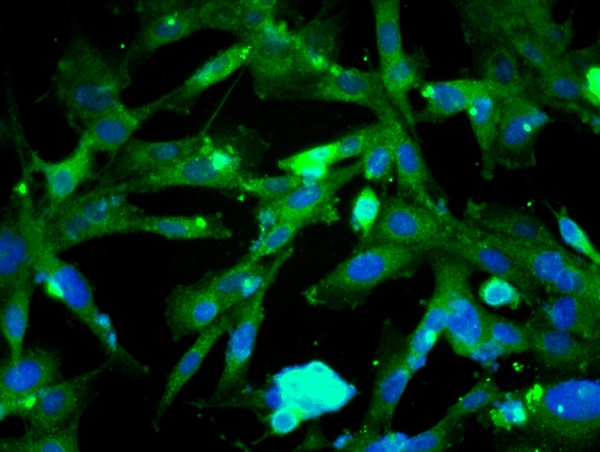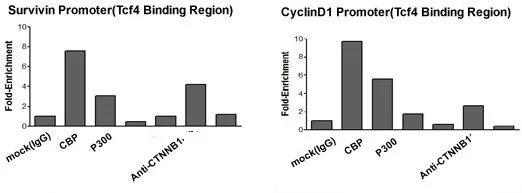beta Catenin antibody [N1N2-2], N-term
GTX101435
ApplicationsFlow Cytometry, ImmunoFluorescence, ImmunoPrecipitation, Western Blot, ChIP Chromatin ImmunoPrecipitation, ImmunoCytoChemistry, ImmunoHistoChemistry, ImmunoHistoChemistry Frozen, ImmunoHistoChemistry Paraffin
Product group Antibodies
TargetCTNNB1
Overview
- SupplierGeneTex
- Product Namebeta Catenin antibody [N1N2-2], N-term
- Delivery Days Customer9
- Application Supplier NoteWB: 1:500-1:20000. ICC/IF: 1:100-1:1000. IHC-P: 1:100-1:1000. FACS: 1:50-1:200. IP: 1:50-1:100. *Optimal dilutions/concentrations should be determined by the researcher.Not tested in other applications.
- ApplicationsFlow Cytometry, ImmunoFluorescence, ImmunoPrecipitation, Western Blot, ChIP Chromatin ImmunoPrecipitation, ImmunoCytoChemistry, ImmunoHistoChemistry, ImmunoHistoChemistry Frozen, ImmunoHistoChemistry Paraffin
- CertificationResearch Use Only
- ClonalityPolyclonal
- Concentration0.13 mg/ml
- ConjugateUnconjugated
- Gene ID1499
- Target nameCTNNB1
- Target descriptioncatenin beta 1
- Target synonymsarmadillo; catenin (cadherin-associated protein), beta 1, 88kDa; catenin beta-1; CTNNB; EVR7; MRD19; NEDSDV
- HostRabbit
- IsotypeIgG
- Protein IDP35222
- Protein NameCatenin beta-1
- Scientific DescriptionBeta-catenin is an adherens junction protein. Adherens junctions (AJs; also called the zonula adherens) are critical for the establishment and maintenance of epithelial layers, such as those lining organ surfaces. AJs mediate adhesion between cells, communicate a signal that neighboring cells are present, and anchor the actin cytoskeleton. In serving these roles, AJs regulate normal cell growth and behavior. At several stages of embryogenesis, wound healing, and tumor cell metastasis, cells form and leave epithelia. This process, which involves the disruption and reestablishment of epithelial cell-cell contacts, may be regulated by the disassembly and assembly of AJs. AJs may also function in the transmission of the contact inhibition signal, which instructs cells to stop dividing once an epithelial sheet is complete.[supplied by OMIM]
- Storage Instruction-20°C or -80°C,2°C to 8°C
- UNSPSC12352203
References
- Microglia Polarization and Antiglioma Effects Fostered by Dual Cell Membrane-Coated Doxorubicin-Loaded Hexagonal Boron Nitride Nanoflakes.Read more
- Neutrophil extracellular traps promote bronchopulmonary dysplasia-like injury in neonatal mice via the WNT/beta-catenin pathway.Read more
- Dickkopf-1 Acts as a Profibrotic Mediator in Progressive Chronic Kidney Disease.Read more
- Fabrication of bFGF/polydopamine-loaded PEEK implants for improving soft tissue integration by upregulating Wnt/beta-catenin signaling.Read more
- Equisetum arvense Inhibits Alveolar Bone Destruction in a Rat Model with Lipopolysaccharide (LPS)-Induced Periodontitis.Read more
- Aspirin Inhibits Fibronectin Expression and Reverses Fibronectin-Mediated Cell Invasiveness by Activating Akt Signaling in Preeclampsia.Read more
- Arvcf Dependent Adherens Junction Stability is Required to Prevent Age-Related Cortical Cataracts.Read more
- Dimethyl fumarate ameliorates lipopolysaccharide-induced acute lung injury by inhibiting NLRP3 inflammasome-mediated pyroptosis through enhancing Nrf2 signaling.Read more
- Glycyrrhizin and its derivatives promote hepatic differentiation via sweet receptor, Wnt, and Notch signaling. Morita A et al., 2021 Dec, Biochem Biophys RepRead more
- Human Pluripotent Stem Cell-Derived Neural Progenitor Cells Promote Retinal Ganglion Cell Survival and Axon Recovery in an Optic Nerve Compression Animal Model. Park M et al., 2021 Nov 20, Int J Mol SciRead more


![IHC-P analysis of human tonsil tissue using GTX34443 beta Catenin antibody [CTNNB1/1508].](https://www.genetex.com/upload/website/prouct_img/normal/GTX34443/GTX34443_20200115_IHC-P_1273_w_23060801_717.webp)


![ICC/IF analysis of HT29 cells using GTX80159 beta Catenin antibody [EM-22]. Green : Primary antibody Blue : DAPI](https://www.genetex.com/upload/website/prouct_img/normal/GTX80159/GTX80159_20191028_ICC-IF_1_w_23061322_986.webp)
![WB analysis of whole cell extracts (30 microg lysate) of HeLa (Lane 1), U-87 MG (Lane 2), COLO 205 (Lane 3), HCT 116 (lane 4), HT-29 (lane 5), MCF7 (lane 6), MDA-MB-231 (lane 7) and A549 (lane 8) using GTX80686 beta Catenin antibody [9F2]. Dilution : 1-3 microg/ml](https://www.genetex.com/upload/website/prouct_img/normal/GTX80686/GTX80686_1951_WB_w_23061322_182.webp)
![FACS analysis of A549 cells using GTX83185 beta Catenin antibody [4D5]. Green : beta Catenin Purple : negative control](https://www.genetex.com/upload/website/prouct_img/normal/GTX83185/GTX83185_20170912_FACS_w_23061322_232.webp)
![IHC-P analysis of human lung tissue using GTX84650 beta Catenin antibody [1F3]. Antigen retrieval : Heat-induced epitope retrieval by 10mM citrate buffer, pH6.0, 100oC for 10min.](https://www.genetex.com/upload/website/prouct_img/normal/GTX84650/GTX84650_2979_IHC-P_w_23061420_370.webp)
